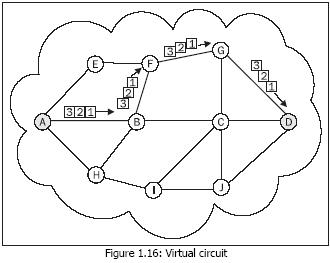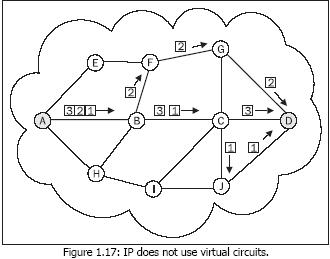|
Virtual Circuit
Some network protocols create virtual circuits in networks. A virtual circuit is
conducted through the network and all packets of a particular connection go via
the circuit. If the circuit gets interrupted anywhere, then the connection is
interrupted, a new circuit is established, and data transmission continues.

In the figure above, a virtual circuit between nodes A and D is established via
nodes B, F, and G. All packets must go through this circuit.
|

Book Excerpt: Introduction to Network Protocols
Chapter Contents
This excerpt from
Understanding TCP/IP: A clear and comprehensive guide to TCP/IP protocols by
Libor Dostálek, Alena Kabelová, is printed with permission from
Packt Publishing, Copyright 2007.
|
|
|
Datagrams can be transmitted via the virtual circuit in two ways:
-
The circuit does not guarantee the datagram's delivery to its destination. (If
network congestion occurs, the circuit can even throw the datagram away.) An
example is the Frame Relay protocol.
-
The virtual circuit can establish a connection and guarantee the data delivery,
i.e., the data packets transmitted are numbered and the destination confirms
their reception. If any data gets lost, a request to resend the data is made.
For example, this mechanism is used in the X.25 protocol.
The advantage of virtual circuits is that they are first established (using
signalization) and then the data is inserted only into the established circuit.
Each packet does not have to carry the globally unique address of the
destination (complete routing information) in its header. It only needs the
circuit ID.
|
The virtual mechanism is not used on the Internet, which was primarily aimed for
use by the U.S. Department of Defense, since the destruction of a node in the
virtual circuit would result in the transmission being interrupted—a fact that
the authors of TCP/IP did not like. For this reason, IP does not use virtual
circuits. Each IP datagram carries a destination IP address (complete routing
information) and is therefore transported independently. If a node is
destroyed, only the IP datagrams currently being transmitted through that
particular node are destroyed. The remaining datagrams are routed via different
nodes.

As the figure above shows, IP datagrams 1, 2, and 3 start from the node A to
node B, but from this point, datagrams 1 and 3 are routed through a different
path than datagram 2. The destination (node D) is then reached by each of them
via a different path. Generally, IP datagrams may reach their destination in a
different order than the order in which they were sent. So our IP datagrams
could be received in the following order: 2, 1, and then 3.
In the Internet hierarchy, TCP—a higher-layer protocol that establishes a
connection and guarantees the delivery of data—is used above the connectionless
IP. If some of the data packets are lost, their retransmission is requested. If
the data packets were lost due to the destruction of a node along the way and
there is another routing possible within the network, then the transmission is
automatically repeated using the other path.
Virtual circuits are divided into the following groups:
-
Permanent (Permanent Virtual Circuit (PVC)), i.e., circuits permanently built
by the network administrator.
-
Switched (Switched Virtual Circuit (SVC)), i.e., virtual circuits that are
created dynamically as the need arises. An SVC is created with the help of
signalizing protocols that can be used for communicating between the user and
the network itself. The network signalizes to the user various events that can
be used for network monitoring and administration. SVC communication consists
of two steps: creating the virtual circuit and using it for communication.
PVC corresponds to leased lines and SVC corresponds to the dial-up lines of a
phone network.
Page 1 | Page 2 |
page 3 | page
4 |
page 5
|